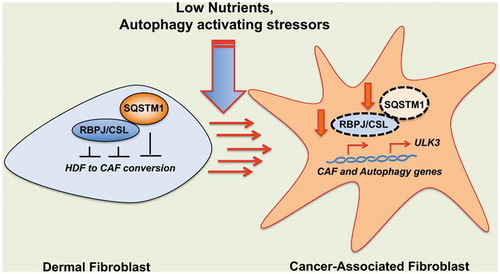Figures & data
Figure 1. Control of RBPJ protein turnover in the tumor microenvironment. The transcriptional repressor that mediates NOTCH signaling, RBPJ, suppresses the gene expression program(s) leading from normal fibroblast to cancer-associated fibroblast (CAF) (left). RBPJ suppresses autophagy and mitophagy through transcriptional repression of the ULK3 gene, which, separately from these processes, causes CAF activation through GLI transcription factors. Conditions inducing autophagy, as often found in tumor stroma, cause the downregulation of RBPJ protein and concomitantly activate key CAF and autophagy effector genes. Mechanistically, RBPJ associates directly with the autophagy/signaling receptor SQSTM1, as part of a self-enforcing loop linking CAF activation with the autophagy process.

